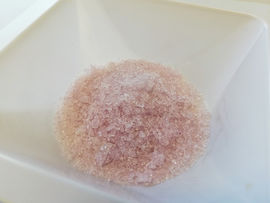Iron(III) nitrate
 Sample of iron(III) nitrate nonahydrate
| |
| Names | |
|---|---|
| IUPAC name
Iron(III) nitrate
| |
| Other names
Ferric nitrate
Iron trinitrate | |
| Properties | |
| FeN3O9 Fe(NO3)3 (anhydrous) Fe(NO3)3·9H2O (nonahydrate) | |
| Molar mass | 241.86 g/mol (anhydrous) 403.999 g/mol (nonahydrate) |
| Appearance | Pale violet hygroscopic crystals |
| Odor | Odorless |
| Density | 1.68 g/cm3 (20 °C) (hexahydrate) 1.6429 g/cm3 (20 °C) (nonahydrate) |
| Melting point | 47.2 °C (117.0 °F; 320.3 K) (Nonahydrate) |
| Boiling point | 125 °C (257 °F; 398 K) (nonahydrate) |
| 150 g/100 ml (hexahydrate) | |
| Solubility | Soluble in acetone, ethanol, methanol |
| Hazards | |
| Safety data sheet | Sigma-Aldrich (nonahydrate) |
| Lethal dose or concentration (LD, LC): | |
| LD50 (Median dose)
|
3,250 mg/kg (rat, oral) |
| Except where otherwise noted, data are given for materials in their standard state (at 25 °C [77 °F], 100 kPa). | |
| Infobox references | |
Iron(III) nitrate, also called ferric nitrate, is the chemical compound with the formula Fe(NO3)3. Since it is deliquescent, it is commonly found in its nonahydrate form Fe(NO3)3·9H2O, in which it forms pale violet crystals. When dissolved, it forms yellow solution due to hydrolysis, as such, small amounts of nitric acid are often added to inhibit hydrolysis.
Contents
Properties
Chemical
Ferric nitrate is the catalyst of choice for the synthesis of sodium amide from a solution of sodium metal in liq. ammonia.
Just like in the case of aluminium nitrate, another salt with three nitrate anions, iron(III) nitrate is rarely chosen as oxidizer in mixtures, due to its hygroscopicity.
Although it has a considerable high oxygen content, ferric nitrate is not used in energetic mixtures due to its deliquescence, not to mention preparing the anhydrous salt is somewhat difficult, as the compound readily hydrolyzes when heated.
Physical
Ferric nitrate is a pale-violet hygroscopic solid, very soluble in water.
Availability
Iron(III) nitrate is sold by chemical suppliers.
Preparation
Iron(III) nitrate can be prepared by treating iron metal powder or shavings with a slight excess of diluted nitric acid.
- Fe + 4 HNO3 → Fe(NO3)3 + NO + 2 H2O.
The solid product is obtained by gently evaporating the water and then dried in an desiccator.
To obtain extremely pure and anhydrous ferric nitrate, the hydrated solid form is gently heated in a stream of nitrogen dioxide, to convert the water into nitric acid, then dried in a vacuum with a cold trap to remove all the HNO3.
Projects
- Source of nitrate
- Make sodium amide
- Make nitric acid
- Make Clayfen reagent (ferric nitrate on montmorillonite)
- Etch silver and silver alloys
Handling
Safety
Iron(III) nitrate is irritant and when dry a powerful oxidizer. Handle it with proper protection.
Storage
In closed air-tight bottles.
Disposal
Can be diluted and poured in the ground, as it's a good source of nitrogen and iron for plants.